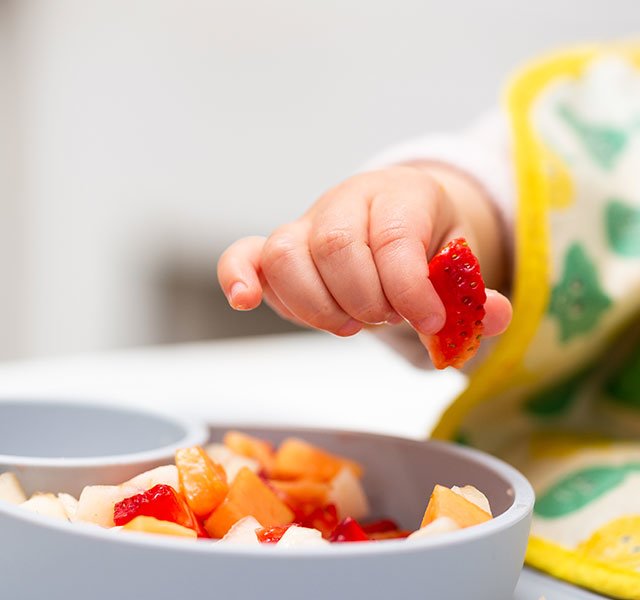Imagine a mealtime where your baby is in the driver's seat when it comes to eating . So instead of spooning peas and sweet potatoes into her wide-open mouth, your child gets to decide what to eat from the family table.
Called baby-led weaning, this style of introducing solids has been used around the world for centuries. "The term became popular in the United Kingdom, Australia and New Zealand where 'weaning' referred to introducing babies to solid foods," says Jacqueline Metz, D.O., a pediatrician at Henry Ford Health.
Baby-Led Weaning Basics
With baby-led weaning, mealtime can be messy, but it's also a more family-friendly way of introducing a child to solid foods.
The basic idea is to skip purées, mashed-up fruit and rice cereal and let babies feed themselves right from the start at about 6 months of age. They sit in a highchair with a spread of finger foods from the family meal, then attempt to transfer the food to their mouths all by themselves.
Before you start baby-led weaning, it's important to watch your infant for signs of readiness (beyond age), including:
- Being able to sit up without substantial support
- Being able to bring their hands to their mouth
- Not spitting out foods or sticking out their tongues when foods are put in their mouths
"It's important to only offer your child soft foods that they can gum and swallow," Dr. Metz says. "Examples include flaked salmon, steamed vegetables like zucchini, squash and sweet potatoes, as well as soft fruits like mango, banana and papaya."
Baby-Led Weaning Pros And Cons
With a growing number of parents bypassing purées and jarred baby food for the appealing alternative of baby-led weaning, it's important to take note of the pros and cons of this approach:
The perks of baby-led weaning include:
- Babies develop strong oral motor skills. Self-feeding requires a fair amount of dexterity and hand-eye coordination. Over time, babies learn to hone these skills as they practice eating.
- Babies learn to self-regulate. Since babies feed themselves independently, they aren't likely to eat more than they need.
- Babies are more willing to eat a variety of foods. Introducing solids in this way — a sort of mishmash of options — allows babies to explore a variety of tastes, textures, smells and colors of foods.
The potential pitfalls of baby-led weaning include:
- Baby-led weaning is messy. With baby-led weaning, your baby gets to explore food, which means smashing, smearing and dropping food at nearly every meal. Since the worst of it will likely land on the floor, consider putting a garbage bag around the chair for easy cleanup.
- Babies might gag. While most babies are quite skilled at self-feeding, gagging is common with baby-led weaning — and it's not the same as choking. Instead, gagging is a reflexive safety mechanism that may cause watery eyes, coughing or sputtering.
- Parents need to be mindful of choking hazards. Choking happens when food becomes stuck in the baby's throat or esophagus — and it can be terrifying. To prevent choking, don’t feed potential hazards, such as grapes, popcorn, hot dogs, raisins, raw vegetables and nut butters.
A Mixed Approach To Feeding
If you choose the baby-led weaning option to introduce solids, your baby might do more licking, tasting and exploring than actual eating during the first several weeks. While they master the art of self-feeding, some families fill the gaps with purées to make meals more filling.
"You don't have to do one or the other," Dr. Metz says. "You can do a mixed approach where you offer some puréed foods and some finger foods." You can even start each meal with a lumpy puree and advance to finger foods during the family mealtime.
No matter which style of feeding you choose, follow these guidelines to keep your baby safe during mealtime:
- Always supervise your baby while he is eating.
- Make sure your baby is sitting up and that her feet can rest on a surface while eating.
- Avoid serving your baby hard foods like apples and raw veggies that are difficult to chew.
- Get certified in infant first-aid.
Not sure if baby-led weaning or a mixed approach is right for you? Talk with your pediatrician. Some children have developmental delays, low tone or other medical problems that take baby-led weaning off the table.
To find a doctor or pediatrician at Henry Ford, visit henryford.com or call 1-800-436-7936.
Dr. Jacqueline Metz is a pediatrician who sees patients at Henry Ford Medical Center - Ford Road in Dearborn.



